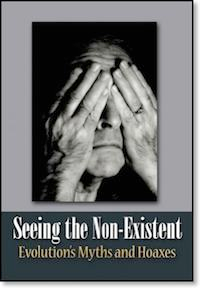866-295-4143, fbns@wayoflife.org

Walt Brown, Ph.D. in mechanical engineering from MIT, observes:
“Most complex phenomena known to science are found in living systems--including those involving electrical, acoustical, mechanical, chemical, and optical phenomena. Detailed studies of various animals also have revealed certain physical equipment and capabilities that the world’s best designers, using the most sophisticated technologies, cannot duplicate. Examples of these designs include molecular-size motors in most living organisms; advanced technologies in cells; miniature and reliable sonar systems of dolphins, porpoises, and whales; frequency-modulated ‘radar’ and discrimination systems of bats; efficient aerodynamic capabilities of hummingbirds; control systems, internal ballistics, and thecombustion chambers of bombardier beetles; precise and redundant navigational systems of many birds, fish, and insects; and especially the self-repair capabilities of almost all forms of life. No component of these complex systems could have evolved without placing the organism at a selective disadvantage until the component’s evolution was complete. All evidence points to intelligent design.
“Many bacteria, such as Salmonella, Escherichia coli, and some Streptococci, propel themselves with miniature motors ... Evolutionary theory teaches that bacteria were one of the first forms of life to evolve, and, therefore, they are simple. While bacteria are small, they are not simple. They can even communicate among themselves using chemicals.
“Some plants have motors that are one-fifth the size of bacterial motors.
“Increasing worldwide interest in nano-technology is showing that living things are remarkably designed--beyond anything Darwin could have imagined” (In the Beginning: Compelling Evidence for Creation and the Flood, p. 19).
The flagellum motor
This microscopic motor-driven propeller propels the sperm cell and certain bacteria. Molecular scientists continue to be amazed at its “apparent” design. Harvard biologist Howard Berg calls it “the most efficient machine in the universe.”
The flagellum motor is composed of a propeller, drive shaft, stator, bushing, u-joint, and is powered by the flow of hydrogen ions.
It can rotate at 6,000 to 17,000 rpm but usually operates at 200 to 1000 rpm.
It can change speeds and reverse direction in a quarter of a turn.
Using this amazing biological motor, the bacteria can propel itself at speeds up to 15 cell lengths per second, which is equivalent to a car traveling 150 miles per hour.
Each shaft rotates a bundle of whiplike flagella that acts as a propeller. Scientists working with ultra-micro devices have learned that the flagella’s whiplike propeller, which at first glance looks awkward and inefficient, is actually perfectly right for propelling a very tiny object through a liquid environment. (See “Making Stuff: Smaller,” NOVA, PBS, 2011.)
“The bacteria can stop, start, and change speed, direction, and even the ‘propeller’s’ shape. They also have intricate sensors, switches, control mechanisms, and a short-term memory” (Brown, In the Beginning, p. 19).
Eight million of the bacterial motors could fit inside the circular cross section of a human hair.
Six thousand years of observation at every level of human existence tells us that even the simplest motor cannot create itself. It is always the product of intelligence, and the more complicated the motor the greater the intelligence necessary to design and build it. The flagellum motor is far more complicated than anything man has built. Common sense unrestrained from naturalistic bias forces the conclusion that this is the product of a very high Intelligence.
Some evolutionists have argued that the flagellum motor could have been “co-opted” from other things. Consider, for example, the following statement:
“The sophisticated components of this flagellum all have precedents elsewhere in nature. In fact, the entire flagellum assembly is extremely similar to an organelle that Yersinia pestis, the bubonic plague bacterium, uses to inject toxins into cells. ... The key is that the flagellum’s component structures ... can serve multiple functions that would have helped favor their evolution” (J. Rennie, “Answers to Creationist Nonsense,” Scientific American, 2002, cited from Jonathan Sarfati, By Design, p. 137).
The simple reply to this is as follows:
(1) To say that the flagellum “could have” been co-opted from parts from other things in nature is a mere “just-so” story with no evidence supporting it. It is an argument built not on scientific fact but on evolutionary assumption and wishful thinking.
(2) Most of the flagellum motor’s components are not found elsewhere in nature and could not therefore have been “co-opted.”
(3) The existence of “parts” found somewhere in nature does not answer the issue of how these were formed in the first place or how they could be combined into a complex working motor. Do dumb bacteria know how to build things? Mutations and natural selection have never been known to create new structures. As Phillip Johnson says:
“... natural selection doesn’t know a thing about bacterial flagella. ... natural selection can only select for preexisting function. ... for co-option to result in a structure like the bacterial flagellum, we are not talking about enhancing the function of an existing structure or reassigning an existing structure to a different function. Rather, we are talking about reassigning multiple structures previously targeted for different functions to a novel structure exhibiting a novel function” (Darwin on Trial, pp. 276, 277).
(4) The incredibly complex instructions for building the flagellum motor are in the bacteria’s DNA. Evolution has never explained scientifically how this information got there.
Dr. Jonathan Sarfati answers this challenge as follows:
“Scientific American’s argument, which comes from Kenneth Miller, and has been parroted by Richard Dawkins, is like claiming that if the components of an electric motor already exist in an electrical shop, they could assemble by themselves into a working motor. However, the right organization is just as important as the right components. Scott Minnich of the University of Idaho, a world expert on the flagellar motor, disagrees with Scientific American and Miller (Minnich points out that Miller, unlike him, has no experience in the area). He says that his belief that this motor has been intelligently designed has given him many research insights. Minnich points out that the very process of assembly in the right sequence requires other regulatory machines. He also points out that only about 10 of the 40 components can possibly be explained by co-option, but the other 30 are brand new” (Sarfati, By Design, pp. 137, 138).
In her zeal to refute the design argument inherent in the complexity of the flagellum motor, one evolutionist has even invoked magic.
“Over at BioLogos, biologist Kathryn Applegate has offered what has to be one of the more creative alternatives to the intelligent design of the bacterial flagellum: Magic. [“Self-Assembly of the Bacterial Flagellum: No Intelligence Required,” The Biologos Forum, Aug. 19, 2010] I'm not kidding. Applegate readily concedes biochemist Michael Behe's point that the flagellum ‘looks and functions just like the outboard motor, a machine designed by intelligent human engineers. So conspicuous is the resemblance that it seems perfectly logical to infer a Designer for the flagellum.’ But, wait, she says:
‘The bacterial flagellum may look like an outboard motor, but there is at least one profound difference: the flagellum assembles spontaneously, without the help of any conscious agent.’ (emphasis added) Acknowledging that ‘the self-assembly of such a complex machine almost defies the imagination,’ Dr. Applegate assures her readers that this is not really a problem because ‘Natural forces work LIKE MAGIC.’ Presto, chango, something appears!” (“Behe Critic on Bacterial Flagellum,” Evolution News & Views, Aug. 25, 2010).
The cargo protein
This tiny device actually walks along tubular pathways transporting vesicles or membrane-enclosed containers to and from the plasma membrane to other parts of the cell such as the Golgi apparatus. The vesicles have different functions depending on what protein materials they contain. They store, transport, or digest cellular products. The tubular pathways themselves are extremely complex. They form out of the centrosome located near the cell’s nucleus and provide not only transportation pathways but also a framework to hold organelles such as the mitochondria. The pathways are dynamic, forming and deforming according to the cell’s needs.
There are an estimated 100,000 of these proteins in each of the one trillion living cells in the human body!
- Receive these reports by email
- www.wayoflife.org
______________________
Sharing Policy: Much of our material is available for free, such as the hundreds of articles at the Way of Life web site. Other items we sell to help fund our expensive literature and foreign church planting ministries. Way of Life's content falls into two categories: sharable and non-sharable. Things that we encourage you to share include the audio sermons, O Timothy magazine, FBIS articles, and the free eVideos and free eBooks. You are welcome to make copies of these at your own expense and share them with friends and family. You may also post parts of reports and/or entire reports to websites, blogs, etc as long as you give proper credit (citation). A link to the original report is very much appreciated as the reports are frequently updated and/or expanded. Things we do not want copied and distributed are "Store" items like the Fundamental Baptist Digital Library, print editions of our books, electronic editions of the books that we sell, the videos that we sell, etc. The items have taken years to produce at enormous expense in time and money, and we use the income from sales to help fund the ministry. We trust that your Christian honesty will preserve the integrity of this policy. "For the scripture saith, Thou shalt not muzzle the ox that treadeth out the corn. And, The labourer is worthy of his reward" (1 Timothy 5:18). Questions? support@wayoflife.org
Goal:Distributed by Way of Life Literature Inc., the Fundamental Baptist Information Service is an e-mail posting for Bible-believing Christians. Established in 1974, Way of Life Literature is a fundamental Baptist preaching and publishing ministry based in Bethel Baptist Church, London, Ontario, of which Wilbert Unger is the founding Pastor. Brother Cloud lives in South Asia where he has been a church planting missionary since 1979. Our primary goal with the FBIS is to provide material to assist preachers in the edification and protection of the churches.
Offering: Offerings are welcome if you care to make one. If you have been helped and/or blessed by our material offerings can be mailed or made online with with Visa, Mastercard, Discover, or Paypal. For information see: www.wayoflife.org/about/makeanoffering.html.





